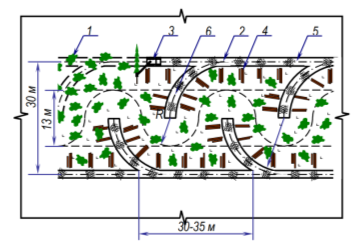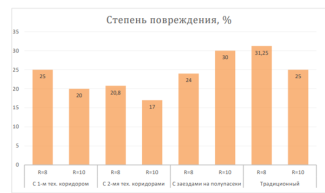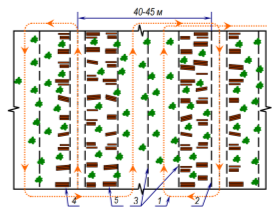Analysis of schemes for the development of cutting areas by multi-operation machines
Авторы: Абрамов Виталий Викторович, Бухтояров Леонид Дмитриевич, Черных Александр Сергеевич, Максименков Алексей Иванович, Афоничев Дмитрий Николаевич, Илунина Анна Александровна, Гудков Андрей Юрьевич, Полукаров Денис Анатольевич
Рубрика: 7. Технические науки
Опубликовано в
XXX международная научная конференция «Исследования молодых ученых» (Казань, январь 2022)
Дата публикации: 11.01.2022
Статья просмотрена: 20 раз
Библиографическое описание:
Analysis of schemes for the development of cutting areas by multi-operation machines / В. В. Абрамов, Л. Д. Бухтояров, А. С. Черных [и др.]. — Текст : непосредственный // Исследования молодых ученых : материалы XXX Междунар. науч. конф. (г. Казань, январь 2022 г.). — Казань : Молодой ученый, 2022. — С. 1-7. — URL: https://moluch.ru/conf/stud/archive/414/16903/ (дата обращения: 24.04.2025).
The article is devoted to the analysis of technological schemes for the production of assortments in a felling area using a harvester and forwarder. The most environmentally friendly options for wood harvesting by a machine method were determined according to the criteria of the area of technological corridors and productivity. The relevance of further research in the direction of predicting the results of the operation of equipment simultaneously with the technical-economic and silvicultural-ecological positions is indicated.
Keywords: assortment technology of logging, schemes for the development of felling areas, felling, processing operations, parameters for the development of apiaries, harvester.
Currently, logging enterprises carry out the entire range of logging and reforestation works, therefore, the issues of damage to the felling area are of great importance [1-2; 3-5; 6-15].
One of the determining factors for maintaining the productivity of the forest environment is a decrease in the share of technological areas in the total area of the cutting area. The scheme with the use of an auxiliary rectilinear corridor (Fig. 1, a) on which only the harvester operates helps to reduce the total length of the main technological corridors (skidding trails) in the felling area. The forwarder works only on the main technological corridors, which are separated from each other at a distance of 3... 3.5 effective reach of the manipulator. When the harvester is working on the main and auxiliary corridors, the entire cycle of operations is performed: felling, delimbing, bucking and bundling. However, assortments are packed into bundles at the maximum distance from the machine. This ensures the availability of bundles formed by the harvester for the manipulator of the forwarder, which moves during the collection of assortments along the main technological corridors.
|
a) |
|
|
|
b) |
|
|
Fig. 1. Technological schemes for the development of cutting areas when using a harvester: a — scheme with one auxiliary corridor; b — scheme with two auxiliary corridors
The option of using two auxiliary corridors (Fig. 1, b) [1, 6] for the work of the harvester allows even more significant reduction in the share of technological areas in the cutting area due to the increase in the width of the cutting area. Here the harvester first cuts adjacent trails spaced up to 45 m apart and develops adjacent half-routes. Then, in two passes, he develops routes that are not adjacent to the trail. In this case, the assortments are stacked in bundles when working on auxiliary corridors only on one side, where they will be accessible for the forwarder manipulator moving along the skidding trail.
The technology of harvesting assortments with the harvester drives into half-cultivation areas (Fig. 2) [2, 6] makes it possible to increase the width of the developed area up to 5 effective manipulator outreaches and also to reduce the proportion of technological areas in comparison with the traditional scheme. The step of entrances to the trail is about 30 m on each side. To ensure a smooth adjoining of the entrances to the trail, they are performed in an arc.

Fig. 2. Technological scheme of the harvester's work with the harvester's arrivals on half-trails
Analysis of the calculation of damage to the forest environment on technological areas (Fig. 3) showed that the largest share of damage is observed when using the scheme of work of the harvester with the harvester drives to the half-trails — 35 %, and the smallest (17 %) when using the scheme with two technological auxiliary corridors for work harvester when the reach of the boom is 10 m.

Fig. 3. Damage to soil, undergrowth and trees in technological areas, depending on the development scheme of the cutting area
Thus, when analyzing the considered schemes for the production of assortments in terms of the share of the technological area and the degree of damage to the main components of the forest environment on it, it was revealed that the most environmentally friendly option for harvesting wood by a machine method is the use of one or two auxiliary corridors for the work of the harvester.
With these two schemes for the development of cutting areas, the degree of preservation of undergrowth, trees and soil is from 80 to 83 %, respectively. At the same time, damage to undergrowth and trees occurs not only on technological areas, but also where part of the stand is left for growing, i.e. between portages or technological corridors:
— when aiming the harvester head at a tree to be cut, from its blows against adjacent trunks (peeling off the bark on the neck and trunk at a height of 1.5 meters from the ground level);
— when the manipulator strikes against growing trees when aiming the head and operating with the tree being processed (peeling off the bark of a small area at a height of up to 3 meters, inclination of the trunk);
— when the tree being processed, which is in the grip of the harvester head, hits the trunks and crowns of growing trees during its felling and further processing (ribbon-like peeling of bark at a significant height, breaking off branches and tops, crumbling of crowns, fracture of trunks of small trees or their inclination, peeling of bark at a height of up to 1 meter);
— when the harvester and especially the forwarder move along the technological corridor due to the lateral roll of machines when moving single obstacles (stumps, stones, rock outcrops);
— at sharp turns on strongly curved routes (peeling off the bark, up to the formation of trees with large damage, peeling off the root necks when the trees are close to the drag) [2-4; 6; 8; 10; 16-18].
In addition, it can be assumed that the use of the considered technologies leads to a decrease in the productivity of the harvester during its operation in auxiliary corridors due to the need to transfer the assortments to the accessibility zone of the forwarder's manipulator.
In this regard, in order to make optimal scientifically grounded design decisions in timber harvesting, it is necessary to develop a methodology for a comprehensive assessment of the execution of logging operations simultaneously with technical, economic and silvicultural and ecological positions, as well as a mathematical apparatus for adequately predicting the result of the functioning of a harvester and forwarder, taking into account various schemes and parameters of work, production conditions and the natural environment.
References:
1. Abramov, V. V. Development and substantiation of effective skidding technology in low-wooded areas: specialization 05.21.01 «technology and machines of logging and forestry»: dissertation for the degree of Candidate of Technical Sciences / Abramov Vitaly Viktorovich; Voronezh state Forestry Academy. — Voronezh, 2009. — 366 p. — Text: direct.
2. Azarenok, V. A. Assortment logging / V. A. Azarenok. — Yekaterinburg: UGLTU, 1999. — 134 p. — Text: direct.
3. Afonichev, D. N. Optimization of the placement of intra-site roads in the raw materials bases of logging enterprises / D. N. Afonichev. — Text: direct // Nature management: resources, technical support. — Voronezh: VGLTA, 2007. — S. 36–42.
4. Afonichev, D. N. Placing a logging bar at the felling area / D. N. Afonichev. — Text: direct // Forest Bulletin. — 2009. — № 3. — S. 92–94.
5. Afonichev, D. N. Improvement of transport development of forest raw materials bases / D. N. Afonichev, P. S. Rybnikov, V. A. Morkovin. — Text: direct // Forestry journal. — 2012. — № 4. — S. 79–88.
6. Bondarenko, A. V. Substantiation of effective environmentally friendly technologies for the development of cutting areas based on mobile rope installations / A. V. Bondarenko, A. S. Chernykh, V. V. Abramov. — Text: direct // Forestry journal. — 2013. — № 2 (10). — S. 111–116.
7. Viktorenko, A. V. Development and research of methods of timber harvesting by a harvester with preservation of undergrowth and trees for growing: специальность 35.04.02 «Technology of logging and wood processing industries»: master's thesis / Viktorenko Anna Vladimirovna; UGLTU. — Yekaterinburg, 2017. — 105 p. — Text: direct.
8. Gerasimov, Y. Y. Environmental optimization of technological processes and machines for logging / Y. Y. Gerasimov. — Joensuu: Publishing house of the University of Joensuu, 1998. — 178 p. — Text: direct.
9. Gerasimov, Y. Y. Cutting machines for thinning: computer decision-making system / Y. Y. Gerasimov, V. S. Syunev. — Petrozavodsk: Publishing house of Petrozavodsk, 1998. — 235 p. — Text: direct.
10. Grigoriev, I. V. The main directions of ensuring the environmental safety of logging production / I. V. Grigoriev, O. I. Grigorieva. — Text: direct // Actual directions of scientific research of the XXI century: theory and practice: a collection of scientific papers based on the materials of the international correspondence scientific and practical conference. — Voronezh: FGBOU VPO «VGLTA», 2015. — S. 202–205.
11. Medium-sparing technologies for the development of cutting areas in the North-West region of the Russian Federation / I. V. Grigoriev, A. I. Zhukova, O. I. Grigorieva, A. V. Ivanov. — Saint-Petersburg: LTA, 2008. — 174 p. — Text: direct.
12. Zaikin, A. N. Theory, methods and models of intensification of logging operations / A. N. Zaikin. — Bryansk: BGITA, 2009. — 212 p. — Text: direct.
13. Zaikin, A. N. Mathematical modeling of operating modes of cutting machines / A. N. Zaikin. — Text: direct // Forest Bulletin. — 2010. — № 1. — S. 69–75.
14. Research of technological options for performing processing operations of cutting operations with chainsaws / I. N. Troyanov, V. V. Abramov, L. D. Bukhtoyarov. — Text: direct // Forestry journal. — 2019. — № 3 (35). — S. 114–130.
15. Increasing the efficiency of sawing wood with a gasoline engine tool/ I. N. Troyanov, V. V. Abramov, L. D. Bukhtoyarov. — Text: direct // Forestry journal. — 2019. — № 1 (33). — S. 128–139.
16. Posharnikov, F. V. Modeling of natural conditions of mountainous terrain in the study of primary forest transport / F. V. Posharnikov, V. V. Abramov, A. V. Bondarenko. — Text: direct // Forestry journal. — 2011. — № 2 (2). — S. 25–29.
17. Improvement of processing operations of cutting work using gasoline-powered tools / A. S. Chernykh, A. I. Maksimenkov, V. V. Abramov. — Text: direct // IOP Conference Series: Earth and Environmental Science. — Voronezh: FGBOU VPO «VGLTA», 2019. — 012039 p.
18. Investigation of technological variants of performing processing operations of logging works using chainsaws / V. V. Abramov, I. N. Troyanov, A. S. Chernykh, A. I. Maksimenkov. — Text: direct // IOP Conference Series: Earth and Environmental Science. — Voronezh: FGBOU VPO «VGLTA», 2019. —012002 p.
Ключевые слова
assortment technology of logging, schemes for the development of felling areas, felling, processing operations, parameters for the development of apiaries, harvesterПохожие статьи
Technological catching-up: co-evolution of learning mechanism and technological capabilities
This paper explores in depth the role of indigenous and foreign innovation efforts in technological change and catching up in emerging economies. It examines the current literature on management of technology (MOT) and stresses the importance of keep...
Enhancing productivity of wells
Maximizing well production is vital for the oil and gas industry. This paper focuses on established and emerging techniques for enhancing well productivity, analyzing their efficacy and limitations. We explore well stimulation methods like hydraulic ...
Improving the removal of sludge in horizontal well sections by turbulizing the drilling mudflow
One of the necessary conditions for ensuring high-quality drilling is efficient transport of drilled rock. When drilling directional and horizontal sections and ensuring sufficient cleaning of the borehole from sludge, it is possible to prevent many ...
Improvement of technology of producing transparent juices using enzymes
To obtaining significant profits in the industrial processing of agricultural raw materials — the creation of waste-free technologies that introduce scientific and technological achievements as well as current production, is one of the most important...
Harnessing big data analytics for strategic decision-making in the digital economy
In the contemporary digital economy, the integration of big data analytics (BDA) into strategic decision-making processes has become a pivotal factor for organizational success and competitive advantage. This paper examines how BDA enhances decision-...
A brief analysis of the application of micro class in surgical teaching
With the development of modern information technology, the concept of mobile communication, social media and educational resource, sharing has come into our teaching system. It has the characteristics of self-learning without the restrictions of time...
Measures to increase oil production
The use of generally accepted technologies for influencing the productive formation and the use of traditional methods of oil production can lead to irreversible processes of deterioration in the porosity and porosity properties of the reservoir in t...
Study of the possibility of increasing the speed limit on highways of the second technical category
Problems of efficient operation of road sections of higher technical categories are identified. The systematization and analysis of modern regulatory requirements and technical solutions for the organization of traffic on roads of technical categorie...
Exploring the influence of blockchain technology on traditional business models in the digital era
The advent of blockchain technology has heralded a transformative shift in traditional business models, particularly in the digital era characterized by rapid technological advancements and evolving consumer expectations. This paper explores the prof...
Instruments and machines for mining industry
To the article touches upon some questions concerning the optimization process of driven rotation and drilling process with the criterion of minimum process costs. An analysis of reducing costs of drilling and boring processes is done, and the indexe...
Похожие статьи
Technological catching-up: co-evolution of learning mechanism and technological capabilities
This paper explores in depth the role of indigenous and foreign innovation efforts in technological change and catching up in emerging economies. It examines the current literature on management of technology (MOT) and stresses the importance of keep...
Enhancing productivity of wells
Maximizing well production is vital for the oil and gas industry. This paper focuses on established and emerging techniques for enhancing well productivity, analyzing their efficacy and limitations. We explore well stimulation methods like hydraulic ...
Improving the removal of sludge in horizontal well sections by turbulizing the drilling mudflow
One of the necessary conditions for ensuring high-quality drilling is efficient transport of drilled rock. When drilling directional and horizontal sections and ensuring sufficient cleaning of the borehole from sludge, it is possible to prevent many ...
Improvement of technology of producing transparent juices using enzymes
To obtaining significant profits in the industrial processing of agricultural raw materials — the creation of waste-free technologies that introduce scientific and technological achievements as well as current production, is one of the most important...
Harnessing big data analytics for strategic decision-making in the digital economy
In the contemporary digital economy, the integration of big data analytics (BDA) into strategic decision-making processes has become a pivotal factor for organizational success and competitive advantage. This paper examines how BDA enhances decision-...
A brief analysis of the application of micro class in surgical teaching
With the development of modern information technology, the concept of mobile communication, social media and educational resource, sharing has come into our teaching system. It has the characteristics of self-learning without the restrictions of time...
Measures to increase oil production
The use of generally accepted technologies for influencing the productive formation and the use of traditional methods of oil production can lead to irreversible processes of deterioration in the porosity and porosity properties of the reservoir in t...
Study of the possibility of increasing the speed limit on highways of the second technical category
Problems of efficient operation of road sections of higher technical categories are identified. The systematization and analysis of modern regulatory requirements and technical solutions for the organization of traffic on roads of technical categorie...
Exploring the influence of blockchain technology on traditional business models in the digital era
The advent of blockchain technology has heralded a transformative shift in traditional business models, particularly in the digital era characterized by rapid technological advancements and evolving consumer expectations. This paper explores the prof...
Instruments and machines for mining industry
To the article touches upon some questions concerning the optimization process of driven rotation and drilling process with the criterion of minimum process costs. An analysis of reducing costs of drilling and boring processes is done, and the indexe...













